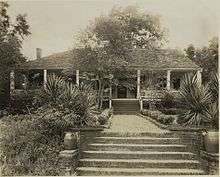Carlos de Grand Pré
| Carlos de Grand Pré | |
|---|---|
 Hope Farm, Natchez, by Frances Benjamin Johnston, 1938. Built by Carlos de Grand Pré, ca. 1789 | |
| Governor of Baton Rouge District | |
|
In office 1805–1805 | |
| Personal details | |
| Born | Unknown |
| Died | Unknown |
| Profession | Soldier and Governor of West Florida |
Don Carlos Louis Boucher de Grand Pré was Governor of the Baton Rouge District of Spanish West Florida (1799-1808) and brevet colonel in the Spanish Army. He was also lieutenant governor of Red River District and of the Natchez District.
Biography
Grand Pré was born in New Orleans on the 25th of October, 1745. He participated in the expansion of the site Baton Rouge by Elias Beauregard, although its original authorization had not been compiled. Ownership of what is now Louisiana changed several times during this time period.
This was illustrated by taking the British military posts of Thompson's Creek and Amite [River?], under the command of Governor Bernardo de Gálvez, and the campaign for Fort Manchac and Fort New Richmond, in 1779. He served as commander of Pointe Coupée[1] and as lieutenant governor of the Red River District, stationed at Avoyelles, under the Spanish regime.[2]
Pré was also commandant of Natchez District between 1786 and 1792.[3] During this period, Pré built two parishes here in an attempt to convert inhabitants to Catholicism; however, the venture was unsuccessful.[4] In 1789, he established the “Concord” mansion in Natchez.[3] In a letter dated March 2, 1790, Carlos de Grand Pré created a list of tobacco farmers in the Natchez District, mainly from Kentucky and Virginia, that outlined production quantities and origination of each farm between the years of 1788 and 1790.[1] After leaving Natchez, he received land around the Avoyelles Post.[1]
In 1799, Boucher de Grand Pré was appointed governor of the Baton Rouge jurisdiction of West Florida.[5] The same year, the new governor proposed that the Spanish settlers from the Canary Islands[6] who lived in Galvez Town settle in the new town of Spanish Town. He drew up the layout of an area east of the fort 'out of cannon shot' which became known as Spanish Town.
As far back as 1804, there had been rumblings against the Spaniards and in August of that year, a group of Americans under the leadership of Reuben Kemper published a declaration of independence, captured the Spanish commander and his alcalde at Bayou Sara, and set out to capture Governor Don Carlos de Grandpre at Baton Rouge. They had hoped to surprise the Spanish official, but Grand Pré was well-warned and the Americans withdrew after a little desultory shooting. The Kempers retired to Pinckneyville, just over the line in the Mississippi Territory, from where they kept up a running battle with the Spanish.
An ultimate result of the activity of the Kempers and when Napoleon was attempting to install his brother on the Spanish throne was the recall of Governor de Grand Pré to Havana by the Captain-general for questioning over his mild policies against the inhabitants. Grand Pré died in Cuba in 1809 while awaiting his trial. According to his friend Pedro Favrot, he was executed for "pro-French" activities.[7] Carlos de Hault de Lassus, who succeeded him as governor of the district of Baton Rouge, was much criticized for accused corruption[7] and taken prisoner during the West Florida revolt in 1810.
References
- 1 2 3 Pre-Statehood History. Posted in claibornecountyms.org. Retrieved on 23 July 2010.
- ↑ Histoire Et Géographie Des Avoyelles En Louisiane Par Corinne L. Saucier, page 32
- 1 2 Lost Mississippi: Concord, Natchez (1789-1901). Posted on May 4, 2010. Retrieved in August 14, 2014, to 14:02.
- ↑ Under-the- Hill Saloon. Archived March 5, 2016, at the Wayback Machine.
- ↑ The Munsons of Texas: JESSE AND ROBERT MUNSON IN MISSISSIPPI AND LOUISIANA 1792-1816.
- ↑ Baton Rouge Historical Markers. From Canary Islanders Heritage Society in Louisiana. Retrieved in=23 July 2010.
- 1 2 (in French) Meyers, Rose A History of Baton Rouge 1699-1812. Page 82.